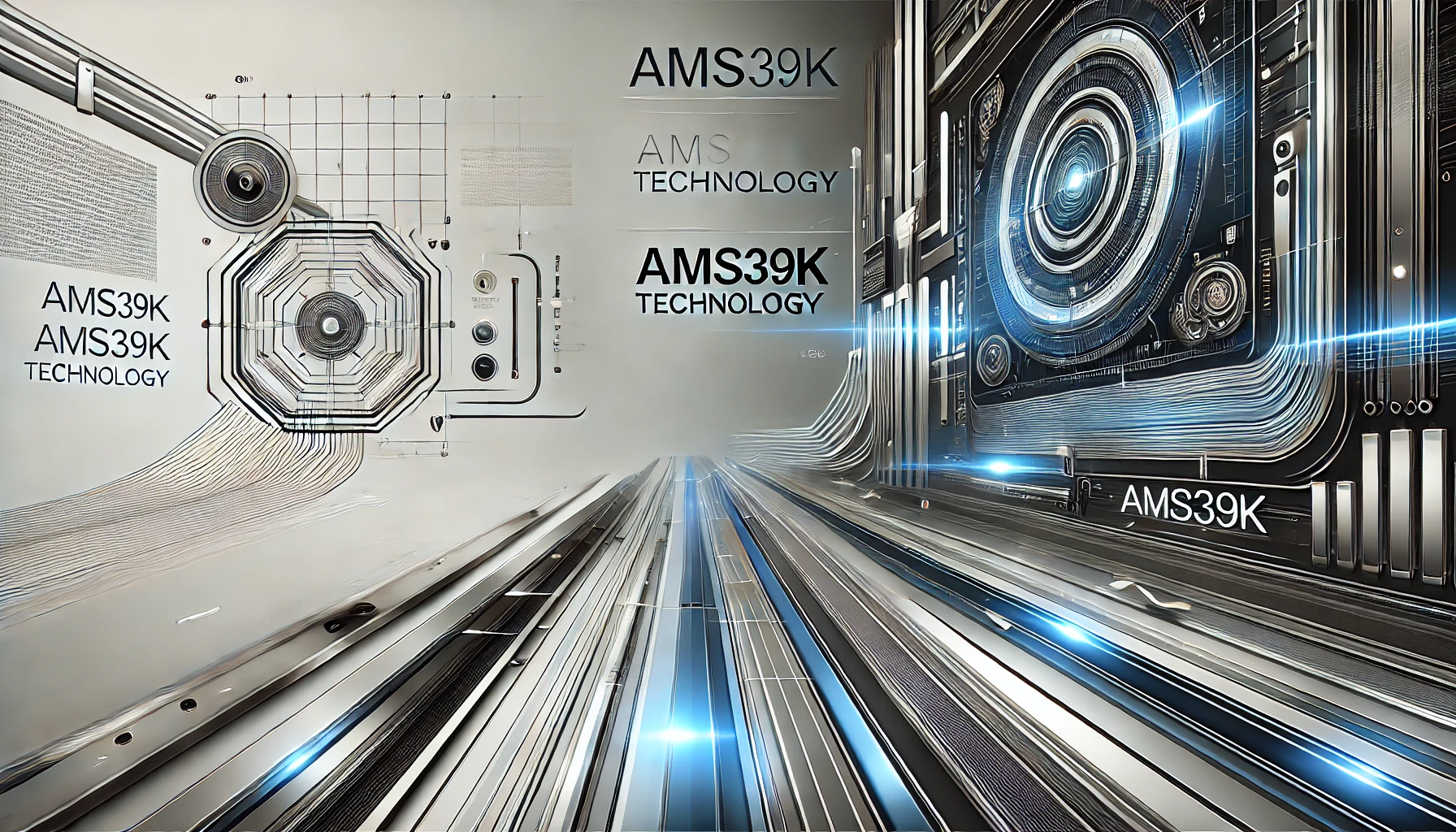AMS39K is a specification widely recognized in industrial and engineering fields for its durable and reliable properties. This specification is essential in industries that demand high-performance materials, such as aerospace and automotive manufacturing. With its robust composition, AMS 39K offers exceptional strength, thermal stability, and resistance to environmental stresses, making it ideal for applications requiring reliability and resilience. This article delves into the core specifications, advantages, and common applications of AMS39K, highlighting why it remains a preferred material choice across various industries.
What is AMS39K?
AMS39K is a specification used in the aerospace and automotive industries for high-performance applications. It outlines the material composition and performance characteristics required for these applications. AMS standards, managed by SAE International, ensure materials meet rigorous criteria for strength, durability, and environmental resistance. AMS 39K typically refers to a specific alloy or composite material, chosen for its reliability in applications requiring high strength, thermal stability, and wear resistance. Components adhering to AMS 39K standards are crucial in sectors prioritizing safety, longevity, and performance.
Key Specifications and Composition of AMS39K
- Composed of high-grade metals, often including steel, nickel, or aluminum alloys, depending on the AMS 39K variant.
- May contain chromium, molybdenum, or titanium to enhance corrosion resistance, strength, and heat tolerance.
- High tensile strength makes it suitable for applications with substantial load-bearing requirements.
- High hardness levels allow it to withstand abrasion, deformation, and wear in high-stress environments.
- Provides a degree of flexibility without compromising structural integrity, essential for absorbing stress without breaking.
- Designed to endure high temperatures without significant degradation, ideal for aerospace and automotive applications.
- Ensures efficient heat dissipation, reducing the risk of overheating and material fatigue.
- Enhanced resistance to corrosion makes it suitable for exposure to moisture, chemicals, and other corrosive elements.
- Resistant to environmental stresses such as UV exposure, oxidation, and other factors that can weaken materials over time.
- Withstands repeated thermal and mechanical cycles, ensuring long-term performance in harsh conditions.
- Meets rigorous testing standards for strength, flexibility, and resistance, following SAE’s Aerospace Material Specifications for certification.
Common Applications of AMS39K
AMS 39K is widely used in industries that demand high-performance materials. In aerospace, it’s essential for components like engine parts and structural elements that require strength, heat resistance, and durability. In automotive manufacturing, AMS 39K is valued for making high-stress parts, such as gears and suspension components. It’s also used in industrial equipment, where resilience to wear, heat, and corrosion is critical for longevity and performance.
Benefits of AMS39K
- High Durability: AMS39K materials are designed to withstand extreme mechanical stress and harsh environmental conditions, ensuring long-lasting performance.
- Superior Heat Resistance: Capable of withstanding high temperatures, AMS 39K is ideal for components exposed to heat, such as engine parts, aerospace structures, and industrial machinery.
- Corrosion Resistance: The material’s resistance to corrosion makes it perfect for use in environments where exposure to moisture, chemicals, or saltwater is common, such as marine and aerospace applications.
- Wear and Abrasion Resistance: AMS 39K excels in applications that involve friction and wear, maintaining its structural integrity even in high-stress, high-wear environments.
- Cost-Effectiveness: Though it offers high performance, AMS 39K provides a reliable, durable option that can reduce long-term maintenance and replacement costs in critical systems.
- Flexibility in Design: The material can be engineered for various applications, allowing for customized solutions in aerospace, automotive, and industrial uses.
- Environmental Adaptability: Resistant to environmental stresses such as oxidation and UV exposure, AMS39K remains stable and reliable across a wide range of conditions.
Future Prospects and Innovations of AMS39K
As industries continue to evolve and demand higher-performance materials, AMS 39K is expected to undergo further advancements to meet the needs of emerging technologies and applications. Here are some of the potential future prospects and innovations for AMS 39K:
- Improved Alloy Formulations:
- Ongoing research is likely to focus on enhancing the composition of AMS 39K, incorporating new elements or optimizing existing ones to improve its strength, thermal resistance, and corrosion properties.
- Hybrid alloys combining AMS 39K with advanced composites could offer even better performance in specific applications, such as aerospace or high-performance automotive parts.
- Enhanced Manufacturing Techniques:
- Innovations in additive manufacturing (3D printing) may allow for more precise and cost-effective production of AMS 39K components, enabling complex geometries and reducing material waste.
- Advanced machining and surface treatment technologies could further improve AMS39K’s performance, such as creating coatings that enhance wear resistance or adding coatings for better heat management.
- Sustainability and Recyclability:
- As industries become more focused on sustainability, AMS39K could see improvements in its environmental impact, with increased recyclability or reduced energy consumption during production.
- Research into greener alloy compositions and production methods could lead to more eco-friendly variants of AMS39K, aligning with global sustainability goals.
- Integration with Smart Technologies:
- In industries like aerospace and automotive, AMS39K could be integrated with smart technologies, such as sensors that monitor material health, temperature, and stress levels in real time. This could lead to smarter, more responsive systems that can predict failures before they occur.
- Broader Applications in Emerging Industries:
- With its excellent performance properties, AMS39K could find new uses in next-generation industries, such as renewable energy (e.g., wind turbines, solar panels), electric vehicles, and even space exploration.
- As manufacturing and design practices evolve, AMS39K may also see broader applications in cutting-edge technologies like robotics, drones, and advanced medical devices.
- Advanced Testing and Certification Standards:
- With the rise of high-performance applications, AMS39K might undergo further rigorous testing to meet new industry standards, ensuring its reliability in even more demanding conditions, such as deep-sea or space environments.
FAQs
Why AMS39K is a Game-Changer?
AMS39K is a game-changer due to its exceptional durability, heat resistance, corrosion resistance, and versatility across multiple high-performance industries.
How does AMS39K help in smartphones?
AMS39K can help in smartphones by providing durable, heat-resistant materials for components like frames, connectors, and heat dissipation systems, improving the phone’s overall performance, longevity, and resistance to wear and tear.
Can AMS39K withstand extreme temperatures?
Yes, AMS39K is designed to withstand extreme temperatures, offering excellent heat resistance, which makes it suitable for high-temperature applications such as aerospace, automotive, and industrial machinery.
Is AMS39K energy efficient?
Yes, AMS39K can be considered energy-efficient due to its ability to withstand high temperatures and mechanical stress without degradation, reducing the need for frequent replacements and maintenance, ultimately saving energy in long-term operations.
Conclusion
In conclusion, AMS39K stands as a highly reliable and versatile material, excelling in high-performance applications that demand durability, heat resistance, and corrosion protection. Its exceptional properties make it indispensable in industries such as aerospace, automotive, and manufacturing, where performance and longevity are paramount. With ongoing innovations in alloy formulations and manufacturing techniques, AMS39K is poised to meet the evolving needs of modern industries, offering both cost-effectiveness and sustainability. Its ability to withstand extreme conditions while enhancing system efficiency makes AMS39K a valuable asset for future technological advancements.



